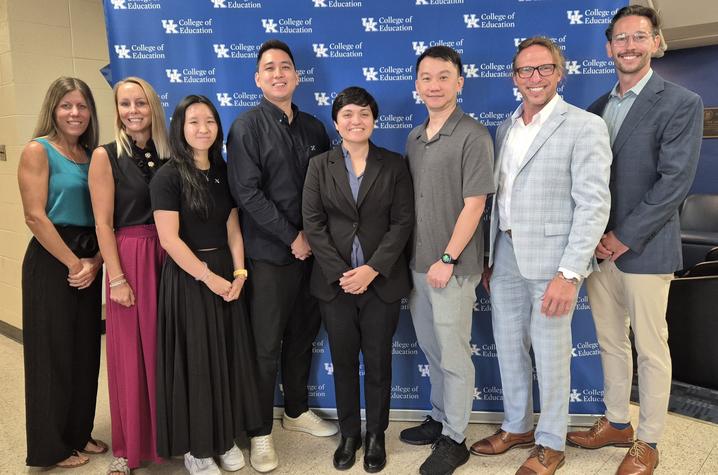Kinesiology and Health Promotion professor enhancing firefighter safety on global scale
LEXINGTON, Ky. (Sept. 24, 2025) — University of Kentucky professor Mark Abel, Ph.D., has been named the first Singapore Civil Defence Force senior (research) fellow. In this role, he is leading collaborative research designed to enhance firefighter safety on a global level.
Abel, who is a former firefighter, is director of the First Responder Research Laboratory in the UK College of Education Department of Kinesiology and Health Promotion. His research team uses scientific methods to better understand how first responders recover during grueling calls. Those data are then used to help improve their health, safety and occupational performance.
“Our research findings guide the development of standard operating procedures that reduce negative impacts on physical and mental health when personnel face high-risk situations,” Abel said. “It’s rewarding to know that research from the University of Kentucky can make a difference locally while also contributing to global safety standards for fire and law enforcement organizations.”
With colleagues in Singapore, Abel is heading Project FIRE (Firefighter Injury Risk Evaluation), a partnership between the Singapore Civil Defence Force (SCDF), Home Team Science & Technology Agency (HTX), Nanyang Technological University (Singapore) and the University of Kentucky. The project focuses on identifying how long firefighters need to recover when facing high-intensity tasks on the fireground and factors that influence individual recovery times.
“Fire and rescue personnel perform arduous occupational tasks, often coupled with intense psychological stress,” Abel said. “They need to be able to perform physically and have the cognitive ability to make critical decisions. Our research in Singapore examines the recovery firefighters need prior to being able to safely reengage work on the fireground.”
Firefighters likely recover at different rates, so Abel and colleagues are identifying metrics associated with the recovery response and determining fitness attributes that are related.
According to Abel, these findings will guide exercise programming and allow recruits and incumbent firefighters to engage in tailored physical training that will enhance their resilience to work fatigue and enable them to recover more quickly.
Leading Project FIRE, Abel spent time at the Responder Performance Centre at the Singapore Civil Defence Academy, which houses the Emergency Responders’ Fitness Conditioning and Enhancement Lab (EXCEL) — an integrated research and development training facility jointly developed by SCDF and HTX, with five specialized labs. There, in concert with HTX and SCDF partners, Abel and Kinesiology and Health Promotion colleague, Ryan Mason, Ph.D., facilitated the trials and provided guidance to firefighters as they participated in the research.
“The EXCEL facility in Singapore, which reflects a gold standard in government-fire service research, provided the ability to control several critical confounding factors, including the environmental conditions all research participants were exposed to. Thus, the use of cutting-edge laboratory facilities enhanced the project’s quality and provided a foundation to move forward with this research,” Abel said.
During the Singapore trials, firefighters conducted operations designed to simulate responding to a high-rise unit fire scenario and performed tasks — such as a ladder climb, hose-carry and casualty evacuation — in a heated environmental chamber. They performed search tasks in a confined space simulator. As the firefighters performed the various tasks, the research team collected their physiological and cognitive data through a series of functional tests.
The research team is analyzing the data to provide evidence-based insights on the work-rest cycle of SCDF frontliners. The findings will be used to enhance firefighters’ safety during training and emergency operations for the international fire service at-large.
This summer, representatives from HTX and SCDF visited UK’s First Responder Research Laboratory, met with faculty in the Department of Kinesiology of Health Promotion and traveled with Abel and Mason to Kansas City, Missouri to present preliminary findings at the annual National Strength and Conditioning Conference.
“The visit from Singapore colleagues allowed us to exchange knowledge, explore new research opportunities and further align our shared priorities,” Abel said. “It’s exciting to see how our shared commitment to firefighter safety can launch ideas that benefit both our local communities and first responders around the world.”
Abel will travel to present additional findings at the Singapore-International Disaster and Emergency Management Expo in November 2025, for which UK’s College of Education is serving as a Knowledge Partner.
Project FIRE was resourced by all partners, and funded, in part, by UK College of Education’s ENSPIRE mechanism.
As the state’s flagship, land-grant institution, the University of Kentucky exists to advance the Commonwealth. We do that by preparing the next generation of leaders — placing students at the heart of everything we do — and transforming the lives of Kentuckians through education, research and creative work, service and health care. We pride ourselves on being a catalyst for breakthroughs and a force for healing, a place where ingenuity unfolds. It's all made possible by our people — visionaries, disruptors and pioneers — who make up 200 academic programs, a $476.5 million research and development enterprise and a world-class medical center, all on one campus.





